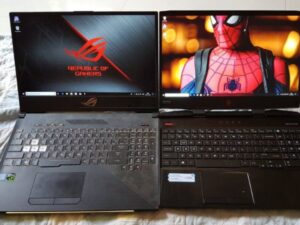What Is The Basic Building Blocks Of Any Computer?

Computers have become an integral part of our daily lives, from personal laptops and smartphones to powerful servers that drive complex systems. Behind the sleek exteriors and user-friendly interfaces, computers are composed of several basic building blocks that work together to process information and perform tasks. Understanding these building blocks is essential to grasp the inner workings of any computer system. However, have you ever wondered What Is The Basic Building Blocks Of Any Computer? In this article, we will explore the fundamental components that form the foundation of every computer system.
Contents
- 1 Central Processing Unit (CPU)
- 2 Memory
- 3 Input Devices
- 4 Output Devices
- 5 Storage Devices
- 6 Operating System
- 7 Software
- 8 Motherboard
- 9 Power Supply Unit (PSU)
- 10 Graphics Processing Unit (GPU)
- 11 Communication Interfaces
- 12 Clock and Timing
- 13 Cooling Systems
- 14 Expansion Slots
- 15 Conclusion
- 16 FAQs (What Is The Basic Building Blocks Of Any Computer?)
Central Processing Unit (CPU)
At the heart of every computer lies the Central Processing Unit (CPU). This electronic component acts as the “brain” of the computer, executing instructions and performing calculations. The CPU consists of arithmetic logic units (ALUs) and control units that fetch, decode, and execute instructions stored in the computer’s memory.
Memory
Memory, often referred to as Random Access Memory (RAM), is a crucial building block of a computer. It provides temporary storage for data and instructions that the CPU can quickly access. RAM allows for efficient multitasking and fast data retrieval, enhancing the overall performance of the computer.
Auto Amazon Links: No products found. No products found. http_request_failed: A valid URL was not provided. URL: https://ws-na.amazon-adsystem.com/widgets/q?SearchIndex=All&multipageStart=0&multipageCount=20&Operation=GetResults&Keywords=What+are+the+basic+building+blocks+of+a+building%3F|Laptops|Samsung+Galaxy+s23|SAMSUNG+Galaxy+S23+Ultra+5G|What+are+the+three+basic+building+blocks+of+computer%3F&InstanceId=0&TemplateId=MobileSearchResults&ServiceVersion=20070822&MarketPlace=US Cache: AAL_aeb4cd9e0848844352e02ca7be936cec
Input Devices
Input devices enable users to interact with computers by providing a means to input information. Examples include keyboards, mice, touchscreens, scanners, and microphones. These devices convert user actions or commands into electrical signals that the computer can understand and process.

Output Devices
Output devices display or present information to the user in a usable form. Monitors, printers, speakers, and headphones are common output devices. They convert digital data from the computer into human-readable or perceivable formats, such as text, images, sounds, or videos.
Storage Devices
Storage devices are used to store data and programs for long-term use. Hard disk drives (HDDs), solid-state drives (SSDs), and optical drives (such as DVD or Blu-ray) are examples of common storage devices. They retain data even when the computer is turned off and provide large capacities for storing files and applications.
Operating System
The operating system (OS) is a vital software component that manages the computer’s resources and provides a platform for running applications. It controls hardware operations, schedules tasks, manages memory, and enables interaction between the user and the computer system.

Software
Software refers to the programs and applications that run on a computer. It encompasses a wide range of applications, from productivity software like word processors and spreadsheets to multimedia tools, games, and specialized software for various industries. Software allows users to perform specific tasks and utilize the capabilities of a computer.
Motherboard
The motherboard is the main circuit board that connects and integrates all other components in a computer system. It provides electrical connections and pathways for data transfer between the CPU, memory, storage, input/output devices, and other peripheral components.
Auto Amazon Links: No products found. No products found. http_request_failed: A valid URL was not provided. URL: https://ws-na.amazon-adsystem.com/widgets/q?SearchIndex=All&multipageStart=0&multipageCount=20&Operation=GetResults&Keywords=What+Is+The+Basic+Building+Blocks+Of+Any+Computer%3F|What+is+the+building+block+of+computer+memory%3F|Samsung+Galaxy+s23|SAMSUNG+Galaxy+S23+Ultra+Cell+Phone|What+are+the+three+basic+building+blocks+of+computer%3F&InstanceId=0&TemplateId=MobileSearchResults&ServiceVersion=20070822&MarketPlace=US Cache: AAL_df345bb09cde731a556a26baf306e2b0
Power Supply Unit (PSU)
The power supply unit is responsible for converting the electrical power from an outlet into the appropriate form to power all the components of a computer. It supplies the necessary voltages and currents to ensure stable and reliable operation.
Graphics Processing Unit (GPU)
The Graphics Processing Unit (GPU) specializes in handling graphical computations and rendering images and videos. It offloads the CPU by performing complex calculations required for displaying high-resolution graphics, running graphic-intensive applications, and accelerating tasks like video editing or gaming.
Communication Interfaces

Communication interfaces facilitate the exchange of data between the computer and external devices. USB ports, Ethernet ports, Wi-Fi modules, Bluetooth adapters, and audio jacks are examples of common communication interfaces. They enable connectivity with peripherals, networks, and other devices.
Clock and Timing
The clock and timing mechanism ensure synchronization and coordination of operations within the computer. The clock generates a steady stream of pulses that dictate the timing of operations, allowing components to work in harmony. It ensures that instructions are executed at the correct time and that data transfers occur accurately.
Cooling Systems
Computers generate heat during operation, and cooling systems are essential to prevent overheating and maintain optimal performance. Heat sinks, fans, and liquid cooling systems dissipate heat generated by the CPU, GPU, and other components, preventing damage due to excessive temperatures.
Expansion Slots
Expansion slots provide the ability to add or upgrade components in a computer system. These slots, commonly found on the motherboard, allow the installation of additional hardware like graphics cards, sound cards, network cards, and storage expansion cards.
Conclusion
Understanding the basic building blocks of a computer is crucial for comprehending its functionality and capabilities. From the CPU and memory to input and output devices, each component plays a vital role in the overall operation of a computer system.
FAQs (What Is The Basic Building Blocks Of Any Computer?)
How does the CPU process instructions?
The CPU processes instructions by fetching them from memory, decoding them to understand their meaning, and executing the necessary operations. It uses its arithmetic logic units (ALUs) to perform calculations and logic operations, manipulating data according to the instructions.
What is the difference between RAM and storage devices?
RAM (Random Access Memory) is a type of volatile memory that provides temporary storage for data and instructions while the computer is running. It allows for fast access and retrieval of information, but its contents are lost when the computer is powered off. Storage devices, on the other hand, provide long-term storage for files and programs, retaining data even when the computer is turned off.
How does an operating system manage resources?
An operating system manages resources by allocating and controlling the computer’s hardware and software components. It schedules tasks, manages memory allocation, controls input/output operations, and ensures efficient utilization of resources. The operating system also provides a user interface and enables communication between the user and the computer.
What are some common input and output devices?
Common input devices include keyboards, mice, touchscreens, scanners, microphones, and cameras. These devices allow users to input information and commands into the computer. Common output devices include monitors, printers, speakers, and headphones, which present information or output generated by the computer in a usable form.








